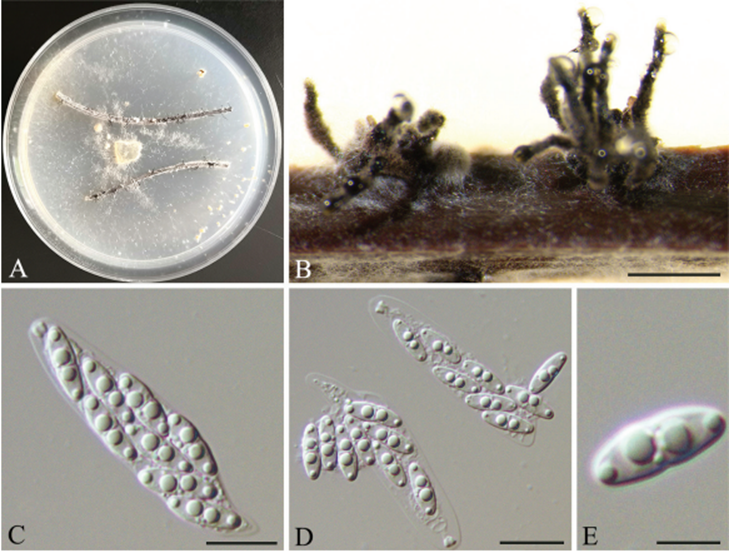 94
94
Diaporthe sojae Lehman, Ann. Mo. bot. Gdn 10: 128 (1923)2021
MycoBank No:
Holotype:
Morphological description
Sexual morph: perithecia on pine needles in culture, black, globose, 250–500 μm in diam., densely clustered in groups, deeply immersed with elongated, tapering perithecial necks protruding through substrata, 525–800 μm. Asci unitunicate, 8-spored, sessile, elongate to clavate, (35–)37–42(–44.5) × (8–)10–11.5 μm (n = 30). Ascospores hyaline, two-celled, often 4-guttulate, with larger guttules at centre and smaller one at ends, elongated to elliptical, slightly or not constricted at septum, (9–) 9.5–11.5 × 2.7–4 μm (n = 30).
Asexual morph not observed.
Cultures: . Culture incubated on PNA at 25 °C, originally white, fluffy aerial mycelium, reverse yellowish pigmentation developing in centre, later becoming dark brown, with yellowish-cream drops exuding from the perithecia after 15 days.
Habitat: on leaves of Camellia oleifera,
Distribution: China. Hunan Province: Zhuzhou City,
GenBank Accession: its MZ509547 ; cal MZ504677 ; bis3 MZ504688; tef1 MZ504699; tub2 MZ504710. Its MZ509548; cal MZ504678; bis3 MZ504689; tef1 MZ504700 ;tub2 MZ504711 . its MZ509549; cal MZ504679; bis3 MZ504690; tef1 MZ504701 ; tub2 MZ504712.
Notes: Diaporthe sojae was first reported on pods and stems of soybean, and subsequently reported on a wide range of hosts (Dissanayake et al. 2015; Udayanga et al. 2015; Guo et al. 2020). It was also reported on some fruit trees in China, such as Vitis spp. (Dissanayake et al. 2015) and Citrus spp. (Huang et al. 2015). In the present, three isolates (HNZZ008, HNZZ010 and HNZZ022) are closely related to D. sojae in the combined phylogenetic tree (Fig. 1). The differences of nucleotides in the concatenated alignment (1/460 in ITS, 3/458 in cal, 1/320 in his3 and 3/433 in tub2) are minor. Compared with the description of the ex-type isolate FAU635, the isolate has wider asci (10–11.5 μm vs. 7–9 μm) (Udayanga et al. 2015). We therefore identify the isolates as belonging to D. sojae.
Reference:[1] Mi, L. I. , Zhen, H. E. , Xiaowu, L. , Yonggang, X. , Xuewu, Y. , & Academy, H. F. . (2015). Investigation on resources and appraisal of dominant species of natural enemies in camellia oleifera forests in hunan province. Hunan Forestry Science & Technology.

Diaporthe sojae (HNZZ022) A Culture on PNA B ascomata C–E asci and ascospores. Scale bars: 500 μm (B); 10 μm (C–E)

